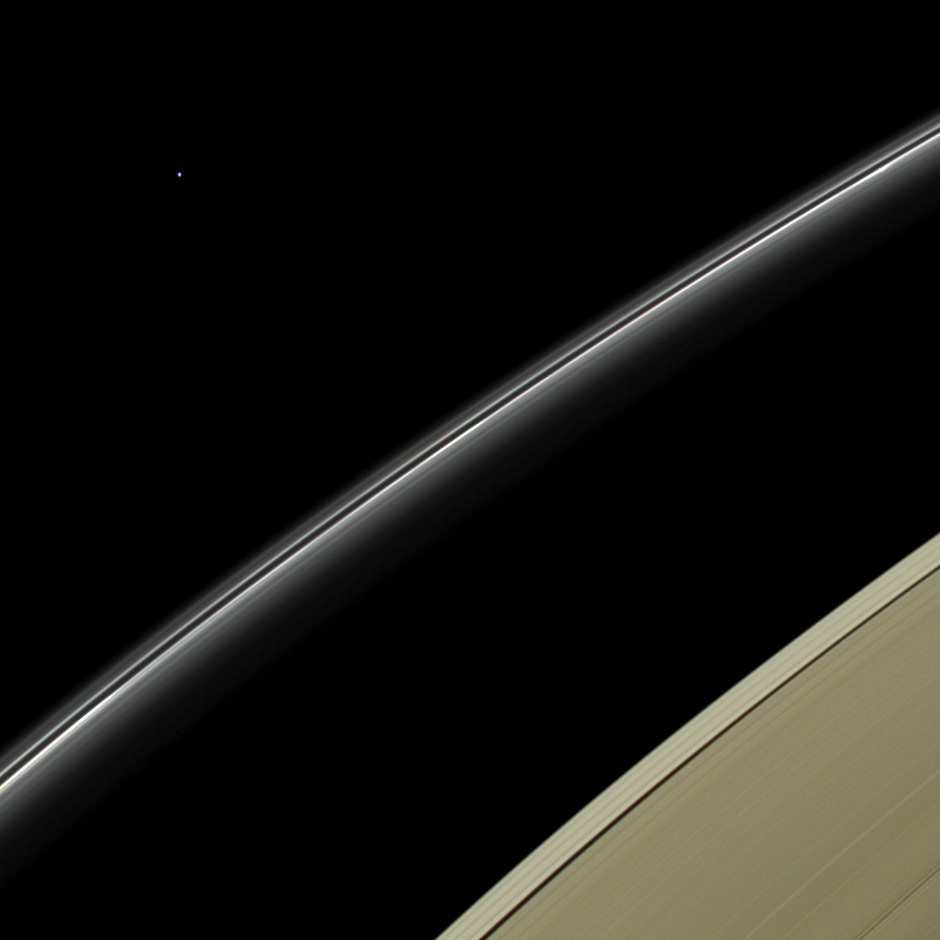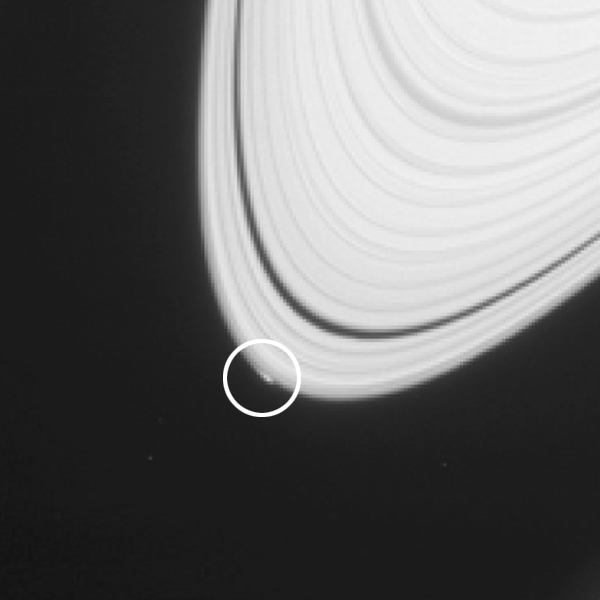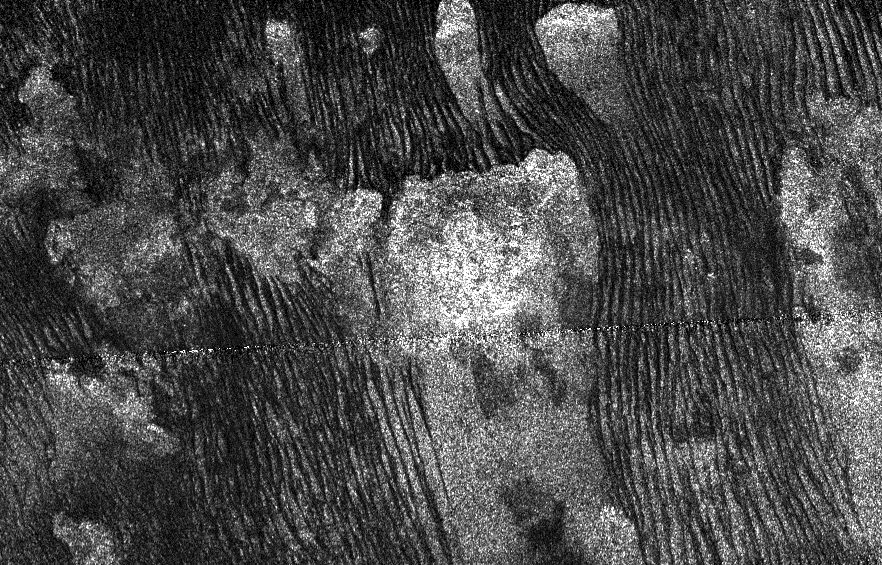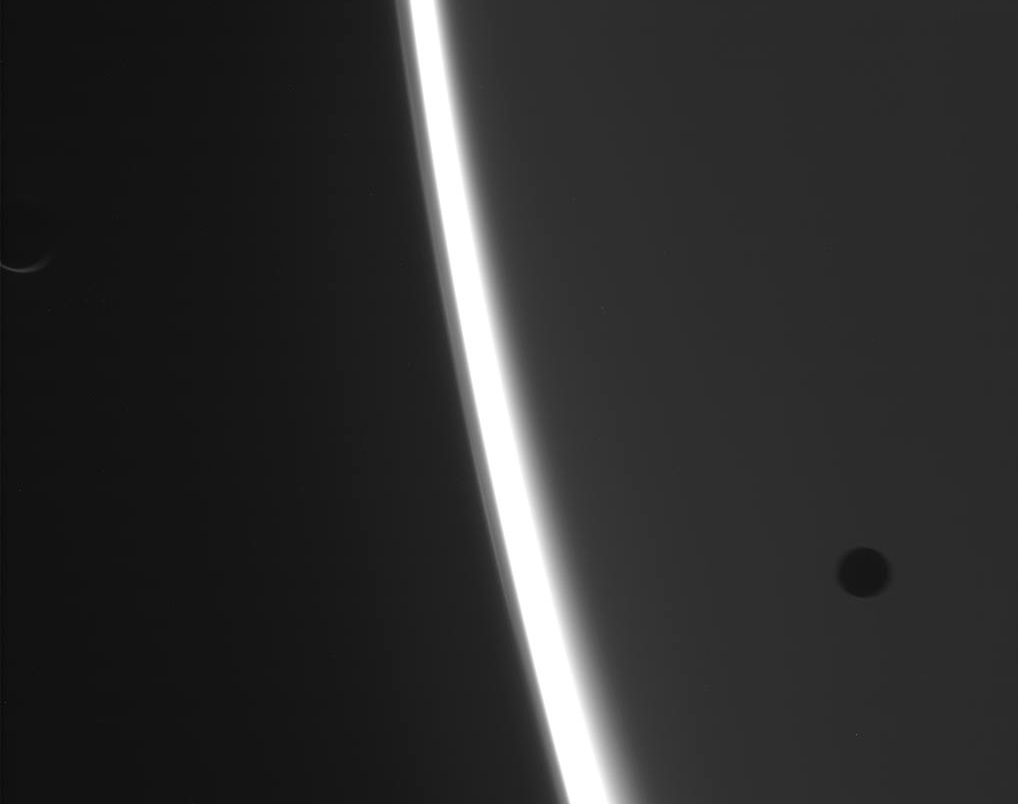Host: Fraser Cain (@fcain)
Guests: Morgan Rehnberg (cosmicchatter.org / @cosmic_chatter), Nancy Atkinson (@Nancy_A)
Continue reading “Weekly Space Hangout – May 2, 2014: Gas Clouds & Photobombs”
Cassini’s View of Another Pale Blue Dot
When you hear the words “pale blue dot” you’re probably reminded of the famous quote by Carl Sagan inspired by an image of Earth as a soberingly tiny speck, as imaged by Voyager 1 on Feb. 14, 1990 from beyond the orbit of Pluto. But there’s another pale blue world in our Solar System: the ice giant Uranus, and its picture was captured much more recently by the Cassini spacecraft from orbit around Saturn on April 11, 2014.
Released today by the Cassini Imaging Team, the image above shows Uranus as a tiny blue orb shining far beyond the bright hazy bands of Saturn’s F ring.
“Do you relish the notion of being a Saturnian, and gazing out from the lofty heights of Saturn at the same planets we see here from the Earth?”
– Carolyn Porco, Cassini Imaging Team Leader
Uranus’ coloration is a result of methane high in its frigid atmosphere. According to the description on the CICLOPS site, “methane on Uranus — and its sapphire-colored sibling, Neptune — absorbs red wavelengths of incoming sunlight, but allows blue wavelengths to escape back into space, resulting in the predominantly bluish color seen here.”
This was also the first time Uranus had been imaged by the Cassini spacecraft, which has been in orbit around Saturn since 2004. In fact its ten-year orbital anniversary will come on July 1.
This image adds one more planet to the list of worlds captured on Camera by Cassini, which made headlines last fall when a glorious mosaic was released that featured a backlit Saturn in eclipse surrounded by its luminous rings, the specks of several of its moons, and the distant dots of Venus, Mars, and the Earth and Moon. Made from 141 separate exposures, the mosaic was captured on July 19, 2013 — known by many space aficionados as “the day the Earth smiled” as it was the first time the world’s population was alerted beforehand that its picture would be taken from over 900 million miles away.
Saturn — with its terrestrial spacecraft in tow — was about 28.6 AU away from Uranus when the image was acquired. That’s about 4.28 billion kilometers (2.66 billion miles). From that distance the glow of the 51,118-kilometer (31,763-mile) -wide Uranus is reduced to a mere few pixels (which required digital brightening by about 4.5x, as well.)
Read more on the Cassini Imaging Central Laboratory for Operations (CICLOPS) page here and in a news release from NASA’s JPL here.
Image credit: NASA/JPL-Caltech/SSI. Source: Carolyn Porco, CICLOPS Director
Video: Carolyn Porco Discusses Her Life at Saturn
Space historian Andrew Chaikin sat down with planetary scientist Carolyn Porco, and she discusses how her career has ended up focusing on the Saturn system. I love how Porco relates how even she has been “blown away” by some of the imagery sent back by the missions — just like the rest of us! — saying she’s had to call members of her team several times to verify she wasn’t looking at computer simulations vs. real images.
Enjoy this candid interview of one of the leading planetary scientists of our day.
Let’s Put a Sailboat on Titan
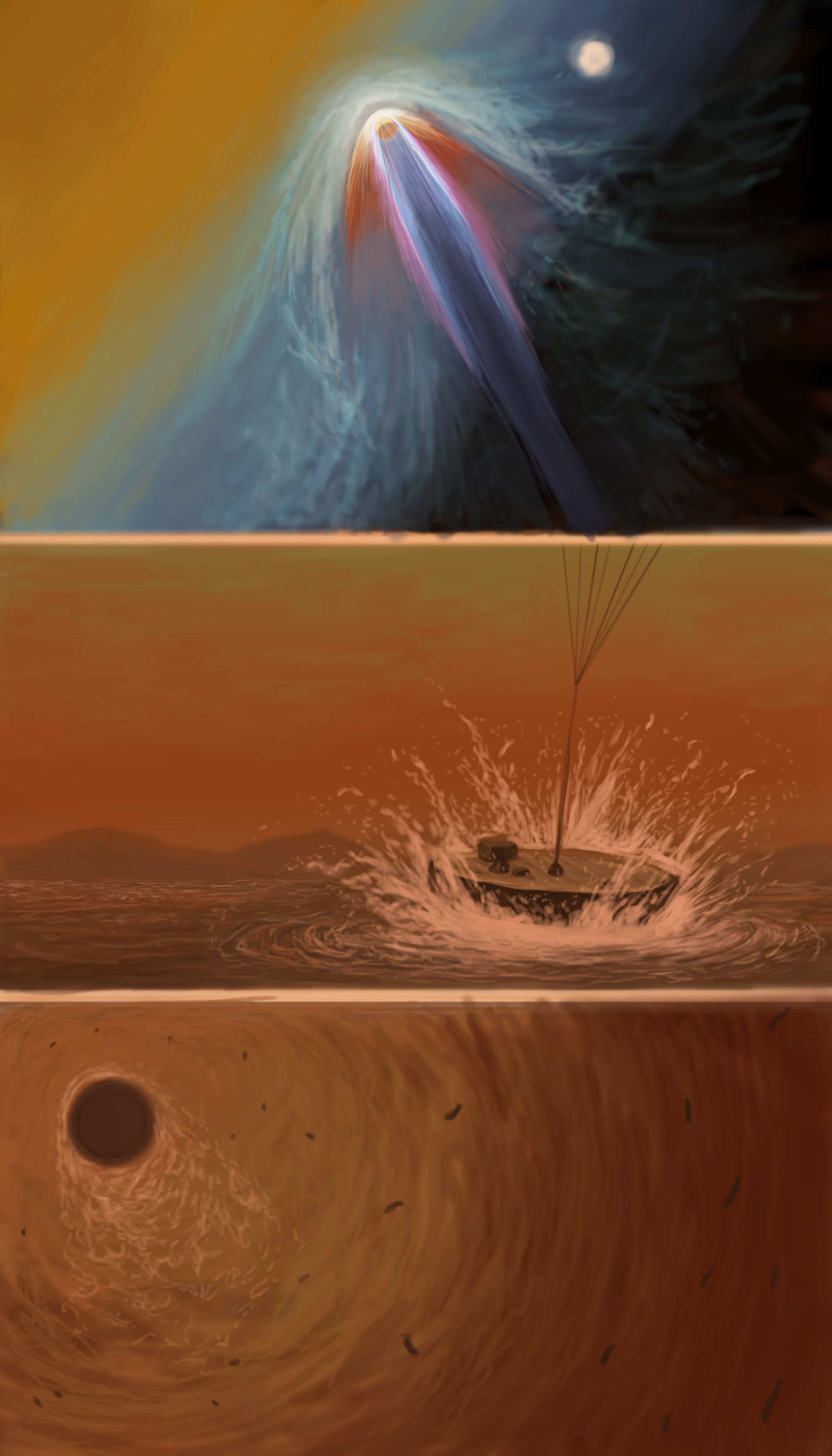
The large moons orbiting the gas giants in our solar system have been getting increasing attention in recent years. Titan, Saturn’s largest moon, is the only natural satellite known to house a thick atmosphere. It’s surface, revealed in part by the Cassini probe, is sculpted by lakes and rivers. There is interest in exploring Titan further, but this is tricky from orbit because seeing through the thick atmosphere is difficult. Flying on Titan has been discussed around the web (sometimes glibly), and this was even one of the subjects treated by the immensely popular comic, XKCD.
However, there remains the problem of powering propulsion. The power requirements for flight are quite minimal on Titan, so solar wings might work. But Titan also presents an alternative: sailing.
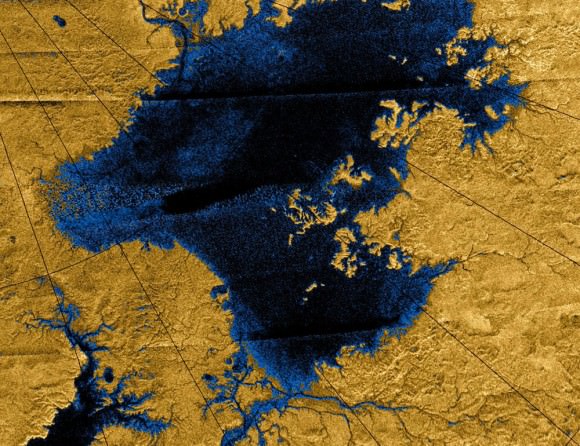
With all those lakes and rivers, exploring Titan with a surface ship might be a great way to see much of the moon. The vehicle wouldn’t be sailing on water, though. The lakes on Titan are composed of liquid methane. The challenge is therefore making the vessel buoyant: liquid methane is only 45% as dense as liquid water. This means we would need a lot of displacement. A deep, hollow hull could do this, however, and it turns out that the liquid methane has an advantage that helps make up for the low density: it is much less viscous than water.
Reynolds number is proportional to the ratio of density to viscosity, and it turns out that friction drag on a hull is inversely proportional to Re. While Titan’s seas and lakes have only 45% the density of water, they also have only 8% of the viscosity. This means that the Titan sailing vessel would only experience about 26% of the friction drag as its Earth equivalent. [Yacht designers have found that the friction drag is about equal to 0.075/(log(Re)-2)^2)]. That leaves us room to make the hull deeper (important to compensate for the density as above), and longer (if we want a longer waterline, which will make the bow waves longer and improve maximum speed).
The sail itself would get less wind, on average, on Titan than Earth. Average wind speeds on Titan seem to be about 3 meters/s, according to Cassini, though it might be higher over the lakes. Average wind speed over Earth oceans is closer to 6.6 meters/s. But, the Titan atmosphere is also about 4x denser than Earth’s, and both lift and drag are proportional to fluid density. All told, this means that the total fluid force on the sail will be about 83% of what you’d get on Earth, all else being equal, which could be sufficient. There would be a premium on sail efficiency and size, and so we might have to take advantage of the low-friction hull to examine shapes with more stability that can house a larger, taller (and presumably high aspect ratio) sail.
This is all quite speculative, of course, but it provides a fun exercise and perhaps provides inspiration as we imagine tall-sailed robotic vessels silently cruising the lakes of Titan.
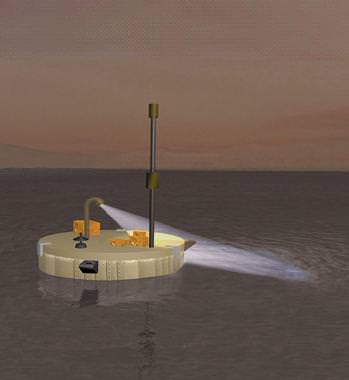
One concept for a boat on Titan has already been proposed: the Titan Mare Explorer (TiME) would send a floating high-tech buoy to land in a methane sea on this moon of Saturn to study its composition and its interaction with the atmosphere. But this Discovery-class mission concept was nixed in favor of sending the InSight lander to Mars.
But with all the recent discoveries on Titan by the Cassini spacecraft — things like lakes, seas, rivers and weather and climate patterns that create both fog and rain — a mission like this will be given more consideration in the future.
Is Saturn Making a New Moon?
Congratulations! It’s a baby… moon? A bright clump spotted orbiting Saturn at the outermost edge of its A ring may be a brand new moon in the process of being born, according to research recently published in the journal Icarus.
“We have not seen anything like this before,” said Carl Murray of Queen Mary University in London, lead author of the paper. “We may be looking at the act of birth, where this object is just leaving the rings and heading off to be a moon in its own right.”
In images acquired with Cassini’s narrow-angle camera in 2013, a 1,200-kilometer-long, 10-kilometer-wide arc of icy material was observed traveling along the edge of the A ring. The arc is thought to be the result of gravitational perturbations caused by an as-yet unseen embedded object about a kilometer wide — possibly a miniature moon in the process of formation.
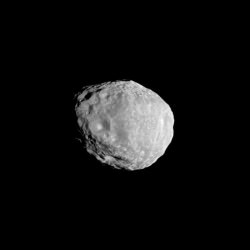
The half-mile-wide object has been unofficially named “Peggy,” after lead author Murray’s mother-in-law (whose 80th birthday it was on the day he was studying the Cassini NAC images.) Murray first announced the findings on Dec. 10, 2013 at the AGU 13 meeting in San Francisco.
According to the team’s paper, Peggy’s effects on the A ring has been visible to Cassini since May 2012.
Eventually Peggy may coalesce into a slightly larger moon and move outward, establishing its own orbital path around Saturn. This is how many of Saturn’s other moons are thought to have formed much further back in the planet’s history. Now, its rings having been depleted of moon-stuff, can only create tiny objects like Peggy.
“Witnessing the possible birth of a tiny moon is an exciting, unexpected event.”
– Linda Spilker, Cassini Project Scientist at JPL
While it is possible that the bright perturbation is the result of an object’s breakup rather than formation, researchers are still looking forward to finding out more about its evolution.
Read more on the NASA/JPL news release here.
To find out more about the Cassini mission visit saturn.jpl.nasa.gov and www.nasa.gov/cassini. The Cassini imaging team’s website is at ciclops.org.
Cassini Sees a “Zen Garden” on Titan
Looking like the flowing designs carved by a Zen gardener’s rake, long parallel dunes of hydrocarbon sand stretch across the surface of Saturn’s moon Titan. The image above, acquired by Cassini in July 2013, reveals these intriguing and remarkably Earthlike landforms in unprecedented detail via radar, which can easily pierce through Titan’s thick clouds.
I’m feeling a little more enlightened already.
Although it piles into dunes like sand does here, Titan’s sand is not the same as what you’d find on a beach here on Earth. According to an ESA “Space in Images” article:
While our sand is composed of silicates, the ‘sand’ of these alien dunes is formed from grains of organic materials about the same size as particles of our beach sand. The small size and smoothness of these grains means that the flowing lines carved into the dunes show up as dark to the human eye.
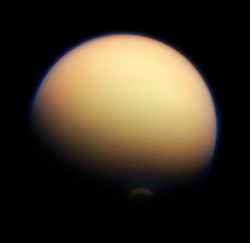
Radar imaging, although capable of seeing through Titan’s opaque orange atmosphere, doesn’t capture visible-light images. Instead it’s sensitive to the varying textures of a landscape as they reflect microwaves; the smoother an object or an area is the darker it appears to radar, while irregular, rugged terrain shows up radar-bright.
The pixelated “seam” cutting horizontally across the center is the result of image artifacting.
Learn more about Cassini’s RADAR instrument here, and read more about this image on the ESA site here.
Cassini Spacecraft Confirms Subsurface Ocean on Enceladus
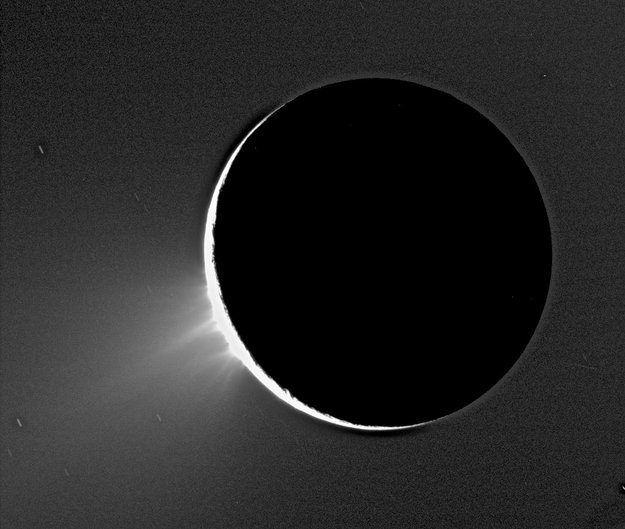
Ever since the Cassini spacecraft first spied water vapor and ice spewing from fractures in Enceladus’ frozen surface in 2005, scientists have hypothesized that a large reservoir of water lies beneath that icy surface, possibly fueling the plumes. Now, gravity measurements gathered by Cassini have confirmed that this enticing moon of Saturn does in fact harbor a large subsurface ocean near its south pole.
“For the first time, we have used a geophysical method to determine the internal structure of Enceladus, and the data suggest that indeed there is a large, possibly regional ocean about 50 kilometers below the surface of the south pole,” says David Stevenson from Caltech, a coauthor on a paper on the finding, published in the current issue of the journal Science. “This then provides one possible story to explain why water is gushing out of these fractures we see at the south pole.”
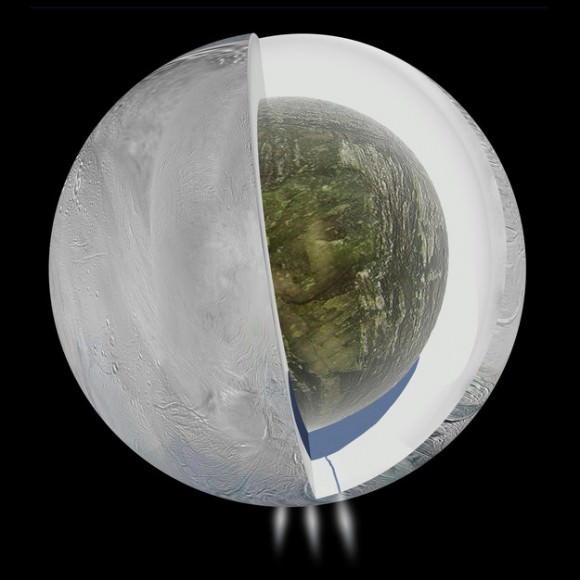
On three separate flybys in 2010 and 2012, the spacecraft passed within 100 km of Enceladus, twice over the southern hemisphere and once over the northern hemisphere.
During the flybys, the gravitational tug altered a spacecraft’s flight path ever so slightly, changing its velocity by just 0.2–0.3 millimeters per second.
As small as these deviations were, they were detectable in the spacecraft’s radio signals as they were beamed back to Earth, providing a measurement of how the gravity of Enceladus varied along the spacecraft’s orbit. These measurements could then be used to infer the distribution of mass inside the moon.
For example, a higher-than-average gravity ‘anomaly’ might suggest the presence of a mountain, while a lower-than-average reading implies a mass deficit.
On Enceladus, the scientists measured a negative mass anomaly at the surface of the south pole, accompanied by a positive one some 30-40 km below.
“By analyzing the spacecraft’s motion in this way, and taking into account the topography of the moon we see with Cassini’s cameras, we are given a window into the internal structure of Enceladus,” said lead author Luciano Iess.
“This is really the only way to learn about internal structure from remote sensing,” Stevenson added.
The only way to get more precise measurements would be to put seismometers on Enceladus’s surface. And that’s not going to happen anytime soon.
Stevenson said the key feature in the gravity data was the negative mass anomaly at Enceladus’s south pole. This happens when there is less mass in a particular location than would be expected in the case of a uniform spherical body. Since there is a known depression in the surface of Enceladus’s south pole, the scientists expected to find a negative mass anomaly. However, the anomaly was quite a bit smaller than would be predicted by the depression alone.
“The perturbations in the spacecraft’s motion can be most simply explained by the moon having an asymmetric internal structure, such that an ice shell overlies liquid water at a depth of around 30–40 km in the southern hemisphere,” Iess said.
While the gravity data cannot rule out a global ocean, a regional sea extending from the south pole to 50 degrees S latitude is most consistent with the moon’s topography and high local temperatures observed around the fractures – called ‘tiger stripes’ at Enceladus south pole.
Many have said Enceladus is one of the best places in the Solar System to look for life. Noted scientist Carolyn Porco and Chris McKay have a recent paper out titled, “Follow the Plume: The Habitability of Enceladus,” where they say that since analysis of the plume by the Cassini mission indicates that the “steady plume derives from a subsurface liquid water reservoir that contains organic carbon, biologically available nitrogen, redox energy sources, and inorganic salts” that samples from the plume jetting out into space are accessible with a low-cost flyby mission. “No other world has such well-studied indications of habitable conditions.”
These latest findings by Cassini make a mission to Enceladus even more enticing.
Paper in Science (paywall) “The Gravity Field and Interior Structure of Enceladus.”
Sources: ESA, Caltech
Surf’s Up on Titan! Cassini May Have Spotted Waves in Titan’s Seas
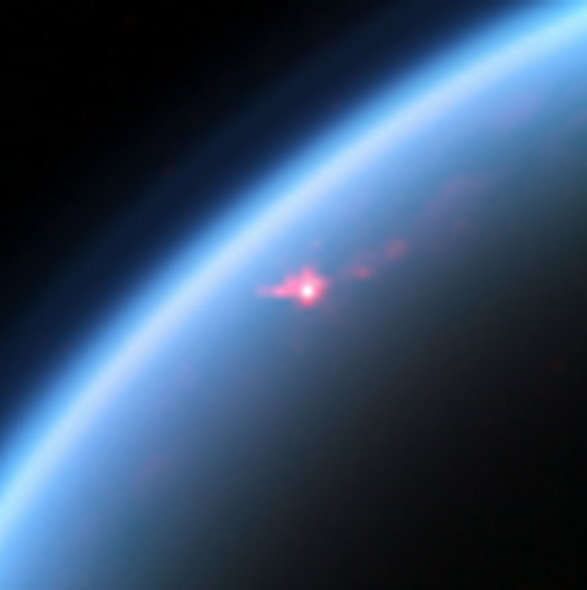
It’s no surprise that Titan’s north polar region is covered with vast lakes and seas of liquid methane — these have been imaged many times by Cassini during its ten years in orbit around Saturn. What is surprising though is just how incredibly smooth the surfaces of these lakes have been found to be.
One would think that such large expanses of surface liquid — some of Titan’s seas are as big the Great Lakes — would exhibit at least a little surface action on a world with an atmosphere as dense as Titan’s. But repeated radar imaging has shown their surfaces to be “as smooth as the paint on a car.” Over the past several years scientists have puzzled over this anomaly but now they may have truly seen the light — that is, reflected light from what could actually be waves on Titan!
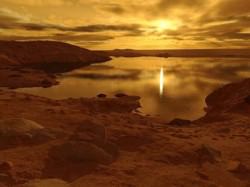
Using data acquired during flybys of Titan in 2012 and 2013, planetary scientist Jason Barnes from the University of Idaho and a team of researchers from several other institutions including JPL, Cornell, and MIT, have identified what might be waves in the surface of Punga Mare, one of Titan’s biggest lakes.
For a sense of scale, Lake Victoria, the largest lake in Africa, could fit lengthwise across Titan’s 380-km (236-mile) -wide Punga Mare.
Read more: Titan’s North Pole is Loaded with Lakes
Variations in specular highlights in four pixels observed in the surface of Punga Mare by Cassini’s VIMS (Visible and Infrared Mapping Spectrometer) have been interpreted by the team as being the result of waves — or, perhaps more accurately, ripples, seeing as that they are estimated to be a mere 2 centimeters in height.
Still, based on what’s been observed thus far on Titan, that’s downright choppy.
If the Cassini observations interpreted by Barnes et al. are indicative of waves in Punga Mare, they could also explain previous specular variations seen in other bodies of liquid, like the smaller Kivu Lacus (top image).
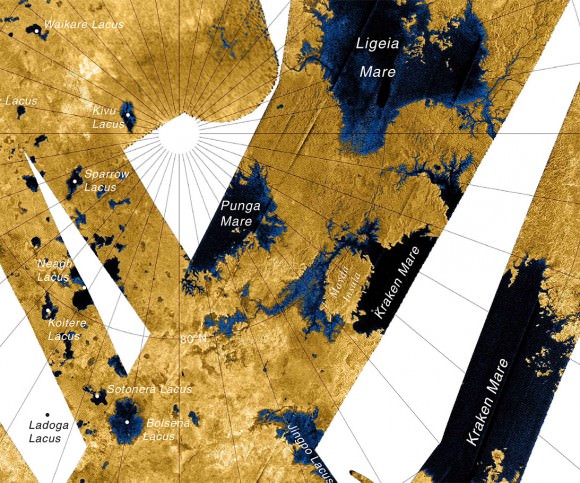
“If correct this discovery represents the first sea-surface waves known outside of Earth.”
– Jason W. Barnes et al.
Then again, wave action isn’t the only possible answer. Similar varied specular highlights could also be caused by a wet surface — like a methane mud flat. Further observations will be needed to rule out other possibilities and obtain a more accurate “surf forecast” for Titan.
The findings were presented by Jason Barnes at the 45th Lunar and Planetary Science Conference in Houston on March 17, 2014. Read the team’s abstract here, and read more in this article by Alexandra Witze on Nature News.
Watch Two Dark Moons Sneak Into Cassini’s Shots
On March 11, NASA’s Cassini spacecraft was acquiring some images of Saturn’s back-lit limb when two of its moons decided to make an entrance. Like stage hands in a darkened theatre the moons quickly passed across the scene, moving between Saturn and the spacecraft and, because of exposure time and spacecraft motion, getting a bit blurred in the process.
In the image above the silhouette of one moon can be seen at bottom right — Mimas, perhaps — while another’s crescent can be made out at upper left… possibly Enceladus. Very cool!
Watch an animation of the moons below:
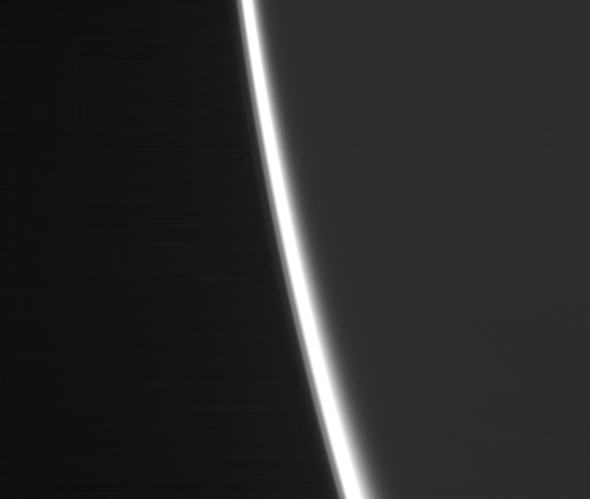
While I admit I’m not 100% sure which moons these are, based on their apparent shapes, positions, and relative sizes I’d make my guess that these are 318-mile (511-km) -wide Enceladus and the 246-mile (395-km) -wide Mimas.
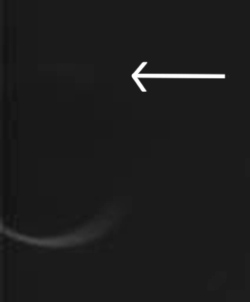
Cassini was 843,762 miles (1,357,903 km) from Saturn when the images were acquired. And, if the larger moon at left is Enceladus, I’m thinking south in these images is up based on the barely-perceptible presence of a lighter area along its top edge that could be icy spray from its southern geysers. (See enlarged detail at right.)
Saturn, of course, is on the right. A small segment of the bright arc of its backlit limb is what’s running diagonally down across the image.
These images have not yet been calibrated or cataloged by NASA or the Cassini team.
See the latest raw images from Cassini on JPL’s mission page here.
*I say “dark moons” but actually Enceladus and Mimas are pretty bright, both being composed of a lot of ice. Enceladus is actually the most reflective world in the Solar System!
Weekly Space Hangout – February 14, 2014: Space Valentines!
Host: Nicole Gugliucci
Astrojournalists: Morgan Rehnberg, Brian Koberlein
Continue reading “Weekly Space Hangout – February 14, 2014: Space Valentines!”

